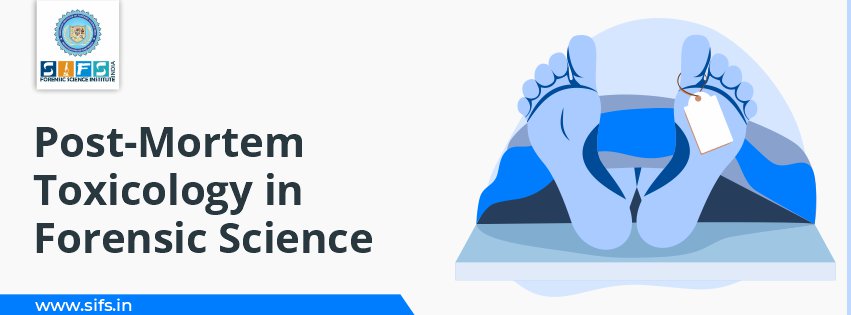- Call Us: +91 7303913002
- Email Us: education@sifs.in
Post-Mortem Toxicology in Forensic Science

BY SIFS India | January 11, 2025
Post-Mortem Toxicology in Forensic Science
Post-mortem toxicology is the study of the presence, distribution and quantification of a xenobiotic after death and there are various biochemical and biological changes that occur after death.
This information is used to account for the physiologic effects of a xenobiotic at the time of autopsy.
It acts as an important tool in forensic science analysing drugs and poisons in body fluids and tissues collected from victims that have died under suspicious circumstances.
To conduct toxicology in a systematic way and analysis of the post-mortem sample is the most challenging task in forensic toxicology because the problems may occur with the changes in the concentration of drugs via bacterial degradation, residual tissue enzymatic activity or post-mortem redistribution from tissues of a high concentration to low concentration.
To identify the cause of death, analysis of tissues is very important.
The range of additional specimens include tissues such as decomposing blood and other tissues, hair, fat, lung, muscle, and even larvae feeding on the host required special techniques to isolate a foreign substance and allow for the detection.
Substance screening techniques are the most important element since they will determine the range of substances and that will target the investigation and provide the initial indication of the possible role of substances in the death.
While immunoassay techniques are used for the most common drug of abuse. Whereas for the general unknown testing chromatographic methods are used and also high-performance liquid chromatography (HPLC) coupled to multichannel wavelength detection was most commonly used, which would easily lend itself to liquid chromatography-mass spectrometry.
This analysis may increase the reproducibility and maybe it leads to more reliable comparable results.
Now a day’s huge numbers of children and adolescents are addicted to drugs to experience a euphoric state of mind, alertness, talkativeness, sexual arousal, and focus on the mind.
But it also has many side effects like anxiety, insomnia, fatigue, mydriasis, agitation, aggression, hallucination etc. and day by day their dependency on drugs increases that have a severe impact on the body both psychologically and physiologically.
They take the drugs like amphetamine, methamphetamine, cocaine, painkillers, alcohol etc.
The users generally snort, inject, smoke or orally consume this kind of drug. For testing the drugs many tests are used, more acceptable tests than the chemical testing of biological fluids the most objective means of drug use.
The standard in post-mortem drug testing is a generally unknown screening by the gas chromatography or mass spectroscopy conducted on a whole blood sample.
The sample can be collected from biological specimens like hair, blood and urine for the analysis of the drug. Many immunoassays designed for urine have been adopted for use in blood and tissue homogenates.
However, immunoassays designed for blood analysis have more useful value than immunoassays designed for urine testing. Post-mortem specimens provide less stability for a number of drugs than other types of specimens.
This is mainly a problem for cocaine, heroin and some antidepressants and benzodiazepines. There is a disadvantage in post-mortem toxicology that many drugs are metabolised so extensively that the parent drug is detected in urine.
It can be solved by using urine screening, it detects the drugs present in urine and in the case of putrefaction specimen the degradation of drugs may occur. Problems are most likely to occur during the isolation and identification of a drug.

